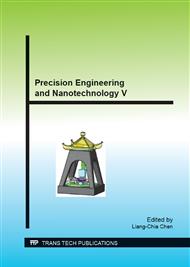p.115
p.123
p.129
p.134
p.140
p.149
p.155
p.161
p.167
Development of a Small Rotary Multi-Jet Abrasive Fluid Jet Polishing Tool
Abstract:
Most optical glasses are in recent years being manufactured by diamond turning processes which has certainly modernized the field of production of optics. Confines of diamond turning for both form and surface finish accuracy have not been reached, yet. In advent of contemporary technology, high precision finishing techniques are of great concern and the need of present industrialized-scenario. This paper presents the development of a small rotary multi-jet abrasive fluid jet polishing tool for use in polishing of optical glasses. The newly designed and manufactured tool has relative angular speed with respect to the spindle of machining centre and is capable of polishing at micro levels. The paper also investigates the optimal polishing parameters for selected, crown optical glass based on experiments conducted using Taguchi’s experimental method. According to the possible number of control factors L18 orthogonal array was used. ANOVA analysis was carried out to determine the main factors which would affect the surface roughness significantly. Consequently, a 2.5 μm size of Al2O3 abrasive, 10wt% abrasive concentration, 40 rpm of polishing head rotation, 6 numbers of nozzles, 6 kg/cm2 of fluid pressure, 45minuet of polishing time and 40% of step over have been found to be the optimal parameters. It was observed that about 97.22% improvements on surface roughness; Ra, from 0.360 μm to 0.010 μm has been achieved using the optimal parameters. In addition to this; rotation of polishing head, applied fluid pressure and polishing time were found to have significant effect on surface roughness improvement.
Info:
Periodical:
Pages:
140-148
Citation:
Online since:
August 2014
Authors:
Price:
Сopyright:
© 2015 Trans Tech Publications Ltd. All Rights Reserved
Share:
Citation:


